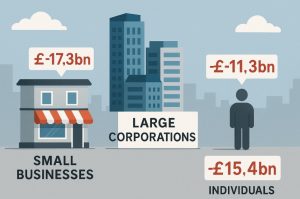Table of Contents
Tax avoidance and evasion have long been significant issues for the UK government, draining billions from the public purse each year.
While the distinction between these two practices is legally important, their combined impact results in substantial losses to the Treasury losses that could otherwise fund critical services such as the NHS, education, and infrastructure.
According to recent data released by HMRC, the UK’s total tax gap reached £36 billion in the 2021–2022 tax year.
This article explores how much tax avoidance costs the UK annually, the factors contributing to this issue, and how government efforts are being directed to tackle the problem.
What Is Tax Avoidance and How Does It Differ from Tax Evasion?

Tax avoidance and tax evasion are two terms often used interchangeably, but they hold distinct legal and ethical differences.
Tax avoidance involves using legal methods to minimise tax liability, such as exploiting loopholes in tax legislation or using offshore structures.
While legal, it often raises moral questions, especially when large corporations avoid paying their fair share of taxes.
In contrast, tax evasion is the illegal act of deliberately misrepresenting or hiding income to reduce tax liability.
This includes underreporting earnings, inflating deductions, or hiding money in undeclared offshore accounts.
The main distinction lies in legality: avoidance is within the law but can be ethically questionable; evasion is a criminal offence.
How Much Is the UK Losing to Tax Avoidance and Evasion Each Year?
According to HMRC’s figures for the 2021 to 2022 tax year, the UK experienced a total tax gap of £36 billion.
This figure represents 4.8 per cent of all expected tax revenues and shows a consistent increase from previous years.
Of the £36 billion total:
- Tax evasion accounted for £4.9 billion.
- Criminal tax activity cost the UK £5.4 billion.
- Tax avoidance resulted in £1.8 billion in losses.
Combined, avoidance and evasion led to £12.4 billion in missed revenue. These numbers reflect not only intentional wrongdoing but also structural weaknesses in enforcement and regulation.
Another area of concern is the growth of the informal economy. A substantial number of UK citizens earn additional income through freelance work, side hustles, or undeclared business activity.
In 2023, around 6.2 million people were estimated to be participating in such work, with much of it falling outside of HMRC’s radar.
The estimated untaxed earnings from undeclared income alone reached £25.7 billion in 2023.
This figure is not included in the official tax gap but reflects a broader trend of underreporting that exacerbates revenue losses.
Which Sectors and Tax Types Are Contributing Most to the Tax Gap?

HMRC’s breakdown of the tax gap reveals which segments of the economy are most responsible for non-compliance and revenue loss. The table below illustrates the financial impact of different taxpayer groups:
Tax Gap by Sector (2021–2022)
| Taxpayer Group | Estimated Loss (£ Billion) |
| Small Businesses | 14.3 |
| Large Businesses | 6.1 |
| Criminals | 5.4 |
| Medium Businesses | 4.6 |
| Individual Taxpayers | 2.6 |
This data highlights the disproportionate impact of small businesses, which contribute nearly 40 per cent of the total tax gap.
While some of this is due to honest mistakes or complexity in the tax system, a significant portion is linked to non-compliance and evasion.
Tax Gap by Tax Type (2021–2022)
| Tax Type | Estimated Loss (£ Billion) |
| Income Tax, NICs, Capital Gains Tax | 12.4 |
| VAT | 7.9 |
| Corporation Tax | 5.1 |
| Excise Duties | 2.9 |
| Other Taxes | 1.7 |
VAT remains a particular concern. Its complexity and the high incidence of fraud have made it a persistent source of lost revenue.
The estimated VAT gap of £7.9 billion suggests widespread underreporting or fraudulent activity, especially among unregistered traders or those manipulating turnover figures.
What Are the Main Reasons Behind Tax Avoidance and Evasion?
The reasons for tax non-compliance in the UK are varied, ranging from genuine errors to calculated fraud. HMRC categorises these causes based on behaviour and intent. According to the 2023 report:
- Failure to take reasonable care accounted for £6.2 billion.
- Criminal attacks were responsible for £5.4 billion.
- Legal interpretation disputes led to £5.0 billion in losses.
- Errors caused an estimated £3.4 billion in tax loss.
- The hidden economy contributed £3.1 billion.
While tax evasion was specifically responsible for £4.9 billion, tax avoidance, a technically legal behaviour, still cost £1.8 billion in the same period.
One of the most significant contributors to the hidden economy is undeclared income. Many individuals, especially those involved in the gig economy or freelance work, fail to report their additional earnings.
Key Statistics from 2023
- 6.2 million people earned money from side jobs, many of whom did not declare this income.
- The total amount of untaxed earnings from undeclared work was £25.7 billion.
This trend is influenced by various demographic and regional factors:
- In London, 31.2 per cent of individuals did not declare side earnings, with average undeclared income at £9,120.
- In the North East, 27.4 per cent failed to declare, averaging £4,120.
- Among men, 20 per cent did not declare earnings, averaging £4,890.
- For women, the figure was 9.1 per cent with an average of £3,250.
The generational breakdown also showed disparities:
- Millennials had the highest rate of undeclared income at 29.1 per cent.
- Generation X followed with 15.2 per cent.
- Baby Boomers reported the lowest at 7.8 per cent.
These figures indicate a widespread issue, not limited to a single group, and show the need for improved education and compliance tools.
How Is HMRC Responding to Tax Avoidance and Evasion?

In recent years, HMRC has stepped up its enforcement efforts, supported by increased government investment. From 2022 to 2025, an additional £1 billion was pledged to boost tax compliance measures, with the goal of recovering £4.5 billion in lost tax revenue.
Key Developments in Enforcement (2022–2023)
- 76,000 reports were made to HMRC’s tax evasion hotline, reflecting a 4 per cent rise from the previous year.
- 4,012 tax evasion cases were recorded, a 5 per cent increase year-over-year.
- 540 individuals were formally charged with tax evasion.
- 625 new criminal investigations were launched by HMRC.
- 225 serious tax evasion cases involving businesses and individuals were investigated.
These figures reflect a concerted effort by HMRC to detect, prosecute, and deter fraudulent activity.
In addition, offshore tax evasion remains a top priority. Since 2010, HMRC has recovered more than £3.2 billion from individuals and entities hiding wealth abroad. The government has invested £2.8 billion in this area alone, supporting international cooperation and data-sharing initiatives.
Despite these efforts, challenges remain in identifying non-compliant taxpayers who operate below the radar or within the grey areas of tax law.
Are There Any Notable Tax Evasion Cases in the UK?
Several high-profile tax evasion cases have highlighted the scale and complexity of the issue in the UK.
One of the most notable was that of Dominic Chappell, the former owner of BHS. In 2020, he was sentenced to six years in prison for evading £584,000 in tax.
He had failed to pay VAT, corporation tax, and income tax on earnings totalling £2.3 million between 2015 and 2016.
The case demonstrated how even prominent business figures can engage in deliberate non-compliance and face severe consequences.
In the realm of offshore tax avoidance and evasion, HMRC has made progress through global transparency agreements.
Since 2010, authorities have recovered billions from previously hidden offshore accounts, with enhanced legislation allowing investigators to obtain financial records across jurisdictions.
These cases not only serve as deterrents but also reinforce the importance of sustained investment in compliance and enforcement measures.
What Is the Economic Impact of Tax Avoidance on Public Services?
The £36 billion lost annually due to the tax gap has a direct and measurable effect on the UK’s public sector. This shortfall limits the government’s ability to invest in key areas such as healthcare, education, and national infrastructure.
Some potential impacts include:
- Reduced NHS funding, leading to longer waiting times and limited resources.
- Underfunded schools, resulting in larger class sizes and fewer support services.
- Delayed or cancelled infrastructure projects, impacting transport, housing, and clean energy initiatives.
Moreover, widespread tax avoidance can damage public trust in the tax system. When large corporations or wealthy individuals exploit loopholes to reduce their tax burden, it places a disproportionate load on ordinary taxpayers and small businesses.
Recovering even a portion of the lost revenue could significantly improve public services and contribute to a more equitable society.
What Steps Can Be Taken to Reduce Tax Avoidance in the UK?

Reducing the tax gap requires a multi-faceted approach involving policy reform, enforcement, education, and international cooperation.
Key strategies include:
- Closing legal loopholes that allow for aggressive tax planning.
- Investing in digital tools and analytics to improve HMRC’s detection capabilities.
- Increasing transparency requirements for multinational companies operating in the UK.
- Promoting awareness campaigns targeting freelancers and gig economy workers.
- Expanding global cooperation through initiatives such as the OECD’s Base Erosion and Profit Shifting (BEPS) framework.
By combining these efforts, the UK can strengthen its tax system, improve compliance rates, and reduce the significant costs associated with avoidance and evasion.
Conclusion
The UK loses billions each year due to tax avoidance and evasion—money that could fund essential services and reduce the tax burden on compliant citizens.
While HMRC has made significant strides in enforcement and recovery, continued efforts are needed to close the tax gap.
Public cooperation, legal reforms, and technological innovation will be vital in ensuring a fair and effective tax system for the future.
FAQs About Tax Avoidance and Evasion in the UK
What is the UK tax gap?
The UK tax gap is the difference between the amount of tax that should be collected and what is actually collected. It includes losses from evasion, avoidance, and other causes.
How does HMRC detect tax evasion?
HMRC uses data analysis, whistleblower reports, financial records, and international agreements to identify inconsistencies and detect fraud or evasion.
Can individuals be prosecuted for tax avoidance?
While tax avoidance is legal, aggressive schemes can be challenged in court. If found to be abusive, users may face penalties or retrospective tax bills.
What is considered undeclared income in the UK?
Any income not reported to HMRC, including freelance work, rental income, or side hustles, is considered undeclared and may result in penalties.
How do offshore accounts contribute to tax evasion?
Offshore accounts can be used to hide income or assets. The UK has joined global efforts to improve financial transparency and combat such practices.
What penalties exist for tax evasion in the UK?
Penalties can include fines, asset seizure, and imprisonment, depending on the severity and intent behind the evasion.
How can small businesses improve tax compliance?
Keeping accurate records, filing on time, using certified accountants, and understanding tax obligations can all improve compliance and reduce risk.


